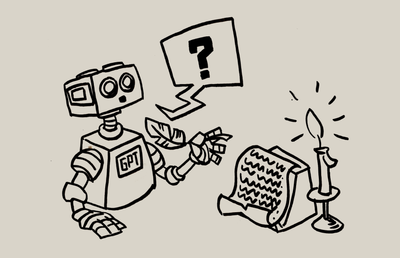Should I Use ChatGPT to Write My Website Content?
From the Journal – Posted 06.11.2025

Writing content using tools like ChatGPT is a tempting shortcut; type in a prompt, and watch a page of content appear in seconds. Simple.
With time, resources, and margins being squeezed more than ever before, the idea of automating website content and copy feels like the answer to every bottleneck.
But while AI tools like ChatGPT, Perplexity, and Claude have become remarkably capable in a short space of time, relying on them entirely isn’t something we’d recommend.
Below, we explore the pros and cons of using AI to produce content, and explain where AI can add real value to this process - and why a human touch is still essential.
The limitations of LLMs
It’s undeniable. ChatGPT (and friends) is a powerful writing assistant. It can summarize complex ideas, draft outlines for blog content, and you can even use it as a sounding board for tone and structural improvements.
Used well - and you have to put effort into prompting - AI can save you hours in brainstorming, research, and content formatting.
But LLMs have their limitations.
Tools like ChatGPT are predictive, not perceptive. They don’t truly think or understand. In short, they predict the most likely next word based on the data they’re trained on.
Nick Livermore, Marketing Manager"Predictive AI is a productivity tool, not a silver bullet for content creation. At the end of the day, platforms like ChatGPT are just very good at guessing. All that is to say that you should 100% be using AI in your content creation workflow. But you should never go straight from prompt to published article."
That means they’re very good at generating fluent, contextually relevant text. But there’s no genuine awareness there, no reasoning, no access to facts beyond training data (which is, admittedly, wide, though not based in any lived experience).
All of that is to say that ChatGPT could be confidently producing inaccurate or misleading information. This is a limitation known as “hallucination” that precludes AI from being a source of absolute truth.
It also means that without human input, LLMs, by their very definition, lack the originality, authenticity, and specific value expected by audiences.
When you shouldn’t use AI to write website content
Given the limitations of LLMs, it should be clear by now that all content creation, to a greater or lesser degree, should receive a human touch.
And it’s especially true of high-value website copy. Your homepage, service pages, product pages, and brand messaging. This should always be written, or at the very least, heavily refined by a professional copywriter.
This category of copy is where clarity, authenticity, and differentiation matter most. And it should be invested in.

Your website is likely your single biggest and most important brand asset. It’s where tone, positioning, and personality come together to differentiate. A templated website featuring over-polished AI slop will give you a cookie-cutter feel devoid of personality.
That said, even here, AI can be useful in the early stages. It’s great for inspiration and ideation. It’s even great for drafts, headlines, and research. But your final copy should come from a professional who understands your business and its goals deeply.
A quick note on data and privacy:
When using tools like ChatGPT, remember that anything you enter may be processed or stored externally. Avoid sharing confidential client information, unpublished work, or sensitive data unless you’re using a privacy-compliant or internal enterprise version of the tool. Treat AI like a contractor and give it only what it needs to do the job.
When AI can help you streamline content creation
That doesn’t mean AI has no place in your content workflow. Especially for information or lower-stakes content - blog posts, FAQs, guides - AI is a fantastic productivity tool. To be honest, if you’re not using it in some way by now, you’re probably wasting time and money.
LLMs can help you:
- Brainstorm topics and keywords
- Get you started with outlines and introductions
- Summarise research or competitor insights
- Suggest ways to make content more readable
- Highlight on topics you may have missed
Used in this way, AI supports your creative process. Think about AI as being additive. It’s a new tool in your arsenal, but it doesn’t replace your other tools (of which one is yourself).
The key is to always layer in your own expertise (fact check!), brand tone, and original perspective before publishing.
But using AI is just bad, isn’t it?
There’s an interesting perspective bouncing around in certain corners of the internet that using AI is bad, full stop. But something is missing here.
People are getting hung up on the wrong thing. The question of whether AI-generated content is inherently bad or not doesn’t really matter.
Nick Livermore, Marketing Manager"I've stopped questioning whether the content I'm reading is AI-generated or not. Instead, you need to ask yourself whether the content you're reading is GOOD. That's what matters. AI can generate good content. But not all AI-generated content is good. Humans can create good content. But not all human-created content is good."
Instead, copywriters and content marketers should be more concerned with whether their content is good. Whether it’s useful.
AI can and does produce good content. Humans can and do produce bad content.
How so-called “good content” is produced doesn’t matter. What matters is that it’s good. The extent to which you can use AI to produce content and have it still be considered “good” depends on the type of content you’re working on.
To put it plainly, your informational content might be taken 75% of the way there by AI, with the remaining 25% being human-driven. Whereas your high-value copy can only progress to 15% before human input, knowledge, and experience are needed.
SEO implications of AI-generated content
Google’s stance on AI content is simpler than you think: quality matters more than authorship. In other words, Google won’t penalise your content purely because it’s generated by AI. If it can even tell.
Instead, Google does what it always does. It evaluates whether your content is helpful, accurate, and trustworthy.
That means AI-generated copy can perform perfectly well in search, as long as it meets the same standards you’d expect of any good content. It should be original, demonstrate expertise, satisfy user intent, and provide value.
💡Further reading: How to optimise your website for AI search
Where things fall apart is when AI content is published without oversight. Hallucinated facts, repetitive phrasing, and missing depth will quickly signal low quality to both readers and algorithms. A good starting place for avoiding this is, as ever, Google’s E-E-A-T (Experience, Expertise, Authoritativeness, Trustworthiness) principles.
Why every piece of content still needs human editing
Even the lowest stakes, most accurate AI-generated content should be reviewed by a human. AI won’t get your tone exactly right, it will make mistakes, the content will sound generic in places, and it certainly won’t add original perspectives that make your content unique or distinctive.

As we’ve already said, AI does hallucinate. And it’s not particularly rare for it to do so. It’s especially likely when it comes to numbers and statistics. It can also misrepresent facts and overstate its claims.
If your goal is to stand out and provide your customers with some genuinely meaningful and uniquely useful content - i.e., value - then your content really should involve a human.
AI is a tool, not a substitute
Used properly, with clear direction and intelligent prompting, AI will make your content creation process faster and better.
AI can absolutely make your content creation process faster and more efficient. But it’s most powerful when used in partnership with human creativity and strategy, not instead of it.
Let ChatGPT help you research, draft, or structure content—but make sure the final voice is unmistakably yours. Because ultimately, great website content isn’t just about words on a page. It’s about communicating your value in a way that feels authentic, intentional, and human.